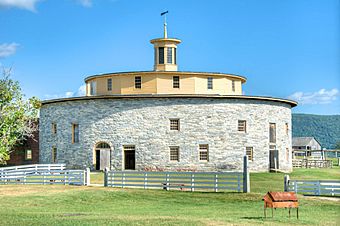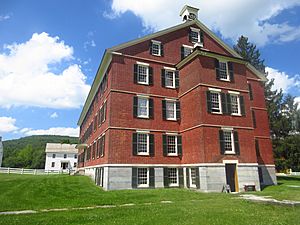Hancock Shaker Village facts for kids
Quick facts for kids |
|
|
Hancock Shaker Village
|
|

The Round Barn
|
|
| Nearest city | Hancock, Massachusetts |
|---|---|
| Built | 1790 |
| NRHP reference No. | 68000037 |
| Added to NRHP | November 24, 1968 |
Hancock Shaker Village is a special place in Hancock and Pittsfield, Massachusetts. It used to be a community for a religious group called the Shakers. This village started in the 1780s and was officially organized in 1790. It was an active Shaker home until 1960.
Hancock Shaker Village was one of 19 main Shaker villages built across New York, New England, Kentucky, Ohio, and Indiana. For many years, it was an important center for Shaker communities in Massachusetts and Connecticut.
In 1960, the Shakers closed the village. A local group bought the property and turned it into an open-air museum. This museum helps people learn about the Shakers' history and way of life. In 1968, it was recognized as a National Historic Landmark District, which means it's a very important historical site.
Contents
How the Shaker Community Was Organized
At its busiest, in the 1830s and 1840s, Hancock Shaker Village had six main groups, called "families." These were the Church Family, Second Family, East Family, West Family, South Family, and North Family.
Each family had two men and two women leaders, known as elders and eldresses. These leaders helped guide their family. The entire Hancock community was overseen by a special group of two elders and two eldresses. This group also looked after other Shaker villages nearby.
Within each family, other leaders called deacons and deaconesses managed daily tasks and businesses. Later, those who handled money and legal matters were called Trustees. This system helped the Shakers live and work together smoothly.
A Look at Shaker History
The Start of the Shaker Faith
The Shaker religion began in Manchester, England, around 1747. They were a group of Christians who believed in equality for everyone and expressed their faith through joyful, energetic worship.
A woman named Ann Lee became their main leader. She believed that people should live a simple life focused on their faith and community, without marriage or families of their own. After facing difficulties in England, Ann Lee and a small group of Shakers sailed to the New York colony in 1774. They settled in Watervliet, New York, creating their first village.
In the late 1770s and early 1780s, many people in New York and Massachusetts became interested in the Shakers. Ann Lee and other leaders traveled to share their beliefs. After Ann Lee passed away in 1784, American converts like Joseph Meacham and Lucy Wright helped organize the Shakers into communal villages. In these villages, everyone shared all property.
Building the Hancock Community
Many farmers in the areas of New Lebanon, Hancock, West Pittsfield, and Richmond joined the Shaker faith starting in the 1780s. This happened after local ministers became Shakers.
Families like the Goodrich, Deming, Osborne, Hammond, and Talcott families joined the community. Other people from nearby towns also became Shakers. These new members helped the Hancock community grow and thrive.
Later Years of the Village
The Hancock Shakers mostly supported themselves through farming. Selling garden seeds was one of their most successful early businesses. They continued to acquire land, and by the 1830s, about 300 Hancock Shakers owned a large amount of land.
After reaching its largest size in the 1840s, the Shaker movement slowly became smaller. Many young people moved to cities for work or headed west. By the early 1900s, only about 50 people lived in the village, many of them children. The remaining Shakers sold off extra land, and some buildings were taken down. In 1960, the decision was made to close the village and sell the property.
People who were not Shakers admired the Hancock Shaker property. It was always clean, neat, and well-kept. They also praised the Shakers' new ideas in farming, like their famous round barn. Visitors also loved the Shakers' products, such as their beautifully made boxes and garden seeds.
Amazing Shaker Buildings
The 1826 Round Stone Barn
One of the most famous buildings at Hancock Shaker Village is the "Round Stone Barn," built in 1826. This barn was built in a circular shape because it was very practical and efficient. It is one of the few round barns still standing in Massachusetts.
Inside the barn, there are four circular areas. The center area helps with air circulation. This is important to keep hay dry and prevent it from molding or catching fire. The next ring was for storing hay. Hay was dropped in from an upper balcony, which wagons could reach using an outdoor ramp. Because the barn was round, wagons could drive in, unload hay, and drive out without ever needing to back up!
The third ring was where Shaker brothers walked to give hay to the cows. The cows stood in the fourth, outermost ring. The barn could hold up to 70 cows. Cows were milked twice a day. They stood in wooden stalls, eating while the brothers milked them. The floor where the cows stood was slightly raised on the inner side. This kept the milk buckets away from any manure, making milking more sanitary.
The Shakers also had a clever way to remove manure. Every few feet around the outer ring, there was a trapdoor. Manure could be quickly scooped through these doors into a pit below the barn. Other workers would then take the manure from the pit to use as fertilizer in their gardens.
The 1830 Brick Dwelling
Another important building is the large red-brick dwelling built in 1830. This building served as a dormitory, providing homes for over one hundred Shaker brothers and sisters. Like the barn, this dwelling shows how successful the Shakers were. It also highlights their appreciation for space, fresh air, and modern conveniences like indoor running water. The dwelling was a great example of the comfortable life the Shaker community offered its members.
Today, visitors to Hancock Shaker Village can enjoy authentic Shaker meals in the dining room of the Brick Dwelling. While guests no longer have to eat separately by gender, the experience feels real. It includes Shaker songs, hymns, and uses natural light or candlelight.
The dwelling also shows how men and women lived separately under one roof. Wide hallways divided the men's rooms from the women's rooms. Separate doors and stairways for men and women meant they didn't have to pass each other in these areas. Men and women also ate at opposite ends of the dining room.
The building had some unique features for its time. It had inside windows to let light into dark stairwells. There were built-in cabinets and drawers, and dumbwaiters to move food and dishes between the kitchen downstairs and the dining room upstairs. There were also many windows for light and fresh air. All the windows were angled at about 45 degrees in the wall. This design allowed about 30 percent more natural light into the building, which helped save on electricity and made the rooms brighter.
The Museum Today
In 1960, the Shaker community at Hancock closed, and its buildings and land were sold. The people who bought it created a non-profit organization called Hancock Shaker Village, Inc. Their goal was to save this historic site. The museum opened on July 1, 1961, and was added to the National Register of Historic Places in 1968. The museum's main goal is to "bring the Shaker story to life and preserve it for future generations."
More than 60,000 people visit the museum each year between April and October. It has 20 historic buildings with over 22,000 artifacts, beautiful gardens, a working farm, and hiking trails. The museum also offers craft demonstrations. Special events happen throughout the year, such as "Baby Animals on the Shaker Farm" in the spring and a "Country Fair" in the fall.
Featured in Films
Hancock Shaker Village has also been a location for films and TV shows. It was featured in Bob Vila's Guide to Historic Homes of America on the A&E Network. In 2012, the village was used as a filming location for a low-budget thriller movie called The Secret Village. The film crew shot scenes there in May 2012, with the movie's exciting ending taking place at the village.
See also





